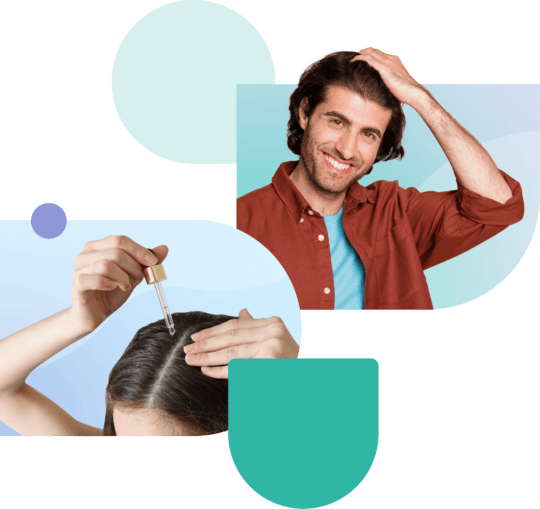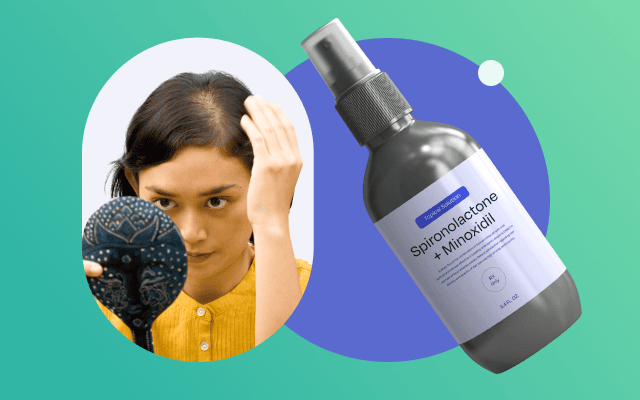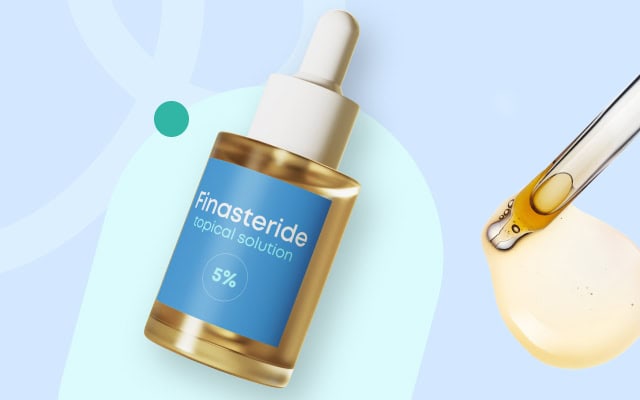We asked a dermatologist how to stop alopecia areata from “spreading”
Dr. Ben Williams, dermatologist, talks about the importance of early intervention and treatment to get control of this condition and if it’s possible to avoid more spots from forming.
Table of Content:
What is alopecia areata? | Causes | Triggers | Symptoms | Treatment | How to actually stop it from “spreading”? | Topical creams | Is there a cure? | Alopecia areata in children | Alopecia universalis | Female alopecia areata
Our commitment to producing high-quality content:
The information presented in this article is based on scientific research and the professional advice of our Content Medical Reviewers, who are experts in the field of Dermatology. How we write our content →
We have asked Dr. Ben Williams, dermatologist, and hair loss expert, how to stop alopecia areata from spreading or developing more bald spots with time. He emphasized that if you have already noticed the emergence of round bald patches on your scalp, beard, or body that tend to go away and pop up again, it’s probable that you have alopecia areata. In this case, early recognition of this condition and understanding the treatment options available based on one’s own severity of this disease may help mitigate developing more bald spots in the future.
What is alopecia areata?
Dr. Ben Williams, dermatologist, and hair loss specialist says alopecia areata is a type of alopecia that typically presents as discrete, smooth, emphasis on “nonscarring” patchy hair loss that may present on the scalp or in other areas with hair growth such as beard, eyelashes and eyebrows. Alopecia areata occurs when the immune system for whatever reason we do not understand mistakenly attacks hair follicles. This autoimmune response leads to hair follicles becoming smaller and eventually ceasing to produce hair, resulting in bald patches1 These bald patches usually grow back with time, but the hairs that grow back in their early stages tend to be of thinner caliber and oftentimes white, a phenomenon called “poliosis”, before becoming the normal hair they once were.
This condition varies in severity for everyone and tends to be more of a spectrum. Some people lose a few patches of hair for a few years that ultimately grows back; whereas, others may lose the entirety of the hair and never see regrowth. Early intervention of the latter described scenario can save hair follicles from their permanent dormancy because after all in the words of Dr. Williams, “Time is hair.”
The general population has an estimated lifetime risk of 2% for developing alopecia areata, resulting in a prevalence of roughly 1 in 1000 individuals2.
What is the best alopecia areata treatment?
These are some commonly used medications for the treatment of alopecia areata.
- Low dose oral minoxidil
- Topical corticosteroids (class 1 TCS)
- Topical anthralin (dithranol)
- Contact immunotherapy
- Olumiant® (Baricitinib)
- LitfuloTM (Ritlecitinib)
- Intralesional corticosteroids
How to get treatment for alopecia areata?
You can have an online consultation for hair loss with a dermatologist for $59. They will evaluate your case and give you a prescription for the best treatment, which may include one or more medications mentioned below.
Is alopecia areata genetic?
To some extent. It is believed that alopecia areata may only occur in individuals who have inherited certain genes that make them more susceptible to this condition, however, the exact cause of this and other autoimmune diseases is not fully understood. Alopecia areata can be triggered by emotional stress, viral infections, or medications. These triggers affect the production of certain substances in the body that are involved in inflammation. Specifically, they reduce the levels of two anti-inflammatory substances affecting the body’s immune response, contributing to hair loss in Alopecia areata.
What causes alopecia areata?
The exact cause of alopecia areata is not fully understood, but current evidence indicates that alopecia areata is primarily autoimmune and may have a genetic component which ultimately can be influenced by unidentified environmental factors. These factors may predispose one who is susceptible to the condition, thus leading to hair loss3.
Potential alopecia areata triggers
Alopecia areata symptoms
- Patches of hair loss (usually circular) in scalp, beard, eyebrows, eyelashes and body
- Nail pitting
In some cases:
- Itching
- Change of color on skin patches
- Visible, mouth-like openings in your hair follicles
- Regrowth of shorter, miniaturized hairs that are thicker on the top and narrow at the base in their early stages
- regrowth with white hairs or poliosis6
So, how to stop alopecia areata from spreading?
Dr. Williams says that for any type of hair loss, not only in the case of alopecia areata, early intervention and appropriate treatment by a dermatologist is the best chance of preventing further hair loss and regrowing your hair back.
Manage your stress levels
There is likely a large connection between stress and alopecia areata since there is scientific evidence that substance P and corticotropin-releasing hormone (CRH) which are produced during emotional stress can initiate or increase the development of alopecia areata7.
Research shows a clear association between mindfulness and reduced levels of depression and anxiety, both through direct and indirect pathways. Factors like suppression, reappraisal, worry, and rumination all played significant roles as mediators in the connection between mindfulness and depression. A similar pattern emerged when examining the relationship between mindfulness and anxiety8.
Oral minoxidil
Although oral minoxidil does not target the anti-inflammatory pathway it is used as an adjunctive treatment for alopecia areata because it is well-tolerated and helps shift more hair into the anagen phase and aids the faster regrowth of hair.
A study conducted where 65 patients with severe and treatment-resistant alopecia areata were given oral minoxidil at a low dose of 5 mg every 12 hours (in addition to a low sodium diet). Results showed that oral minoxidil led to faster and more extensive hair regrowth compared to its topical counterpart9.
Furthermore, an article published by the American Academy of Dermatology (AAD) suggests that it is advisable to prescribe a low-dose oral minoxidil for various hair loss types as it effectively enhances hair thickness and overall volume. While hypertrichosis (excessive hair growth) may occur, most patients are highly satisfied with the results, often choosing to manage the excess hair through methods like epilation or depilation while continuing the treatment10.
Topical corticosteroids (clobetasol propionate)
This is usually a good starting point for less severe cases as it is anti-inflammatory; however, in topical formulation, it is less effective than intralesional since the hair shafts are deeper in the skin and topical absorption happens to a lesser degree than intradermal injection.
Studies conducted in children and adults with moderate to severe alopecia areata showed that the application of a topical 0.05% clobetasol propionate foam demonstrated significantly better scalp hair growth, with 70% to 90% of children and adults achieved significant hair regrowth with some of them experiencing complete hair regrowth11.
Topical anthralin (dithranol)
Anthralin (also known as dithranol), is a synthetic substance derived from coal tar. Its use is becoming less frequent today but still is used by some dermatologists. Research has shown the effectiveness and tolerance of topical anthralin for the treatment of pediatric alopecia areata in treatment duration of at least 6 months to attain a hair regrowth rate exceeding 75%12.
Intralesional corticosteroids
Numerous studies have established the effectiveness of intralesional corticosteroid injections in treating alopecia areata. A particular study reported a remarkable hair regrowth rate of 71% in patients with subtotal alopecia areata with triamcinolone acetonide injections.
Triamcinolone acetonide is the most commonly utilized agent, typically in concentrations ranging from 2.5 to 10 mg with 5 mg being the preferred choice for scalp and facial areas. The corticosteroid is administered into the deep dermis or just below the dermis in the upper subcutaneous layer, with the option for repeat injections every 4 to 6 weeks. To reduce injection discomfort and ensure a more uniform procedure, an alternative approach involves mesotherapy multi-injectors equipped with 5 to 7 needles. It’s important to note potential side effects such as skin atrophy and telangiectasia (enlargement of small blood vessels), which can be minimized by using smaller volumes and avoiding superficial injections13.
Contact immunotherapy
Contact immunotherapy is a less common to very rarely used treatment approach used for alopecia areata. This therapy involves applying a specific substance to the affected skin areas to stimulate an immune response. The goal is to provoke an allergic reaction on the scalp or other affected areas, which can then lead to hair regrowth by altering the immune response locally.
Topical Diphencyprone (DPCP)
DPCP is one of the most widely used substances for contact immunotherapy. It is applied topically to the bald patches on the scalp or other affected areas. DPCP causes a mild allergic reaction in the skin, which can trigger the immune system to target the hair follicles and promote hair regrowth. Treatment typically involves applying DPCP solutions with increasing concentrations over several weeks until a mild skin reaction occurs. After that, maintenance treatments are usually required14.
Topical Squaric Acid Dibutyl Ester (SADBE)
SADBE is another substance commonly used for contact immunotherapy in alopecia areata. Like DPCP, it is applied topically to the affected areas to stimulate an allergic response in the skin. Treatment protocols and concentrations may vary depending on the individual’s response and the healthcare provider’s recommendation15.
Contact immunotherapy is considered when other treatments for alopecia areata have not been effective, especially in cases of severe or extensive hair loss. It is typically administered under the supervision of a dermatologist or healthcare professional experienced in this treatment approach. While contact immunotherapy can be effective in promoting hair regrowth in some individuals, it is not without side effects, and the treatment process can be lengthy. Additionally, not everyone responds positively to this therapy, so its suitability should be determined on a case-by-case basis.
Topical Dinitrochlorobenzene (DNCB)
Dinitrochlorobenzene (DNCB) is another substance used as a contact immunotherapy for alopecia areata in some cases. Similar to DPCP (Diphencyprone) and SADBE (Squaric Acid Dibutyl Ester), DNCB is applied topically to the affected areas of the scalp or skin to induce an allergic reaction. This allergic response can help stimulate the immune system to target the hair follicles and promote hair regrowth in individuals with alopecia areata16.
Dr. Williams says that the choice between DPCP, SADBE, and DNCB may depend on the individual’s response to treatment, the preferences of the healthcare provider, and the availability of these substances in specific regions or healthcare settings. The safety and effectiveness of these treatments can vary among individuals, and they should always be administered under the supervision of a dermatologist or healthcare professional.
Olumiant® (Baricitinib) for severe alopecia areata
Baricitinib (commercially known as Olumiant), a Janus kinase (JAK) inhibitor, is the leading drug for the treatment of severe alopecia areata in both the USA and the EU. Treating severe alopecia areata is challenging, often marked by frequent relapses. Clinical trials involving adults with severe alopecia areata taking daily oral administration of Olumiant exhibited clinically significant regrowth of scalp, eyebrow, and eyelash hair over a span of 36 weeks. Olumiant was generally well-tolerated, with the most common adverse events including infections, headaches, acne, and elevated levels of creatine phosphokinase. Existing data strongly suggest that baricitinib serves as a valuable treatment option for individuals with severe alopecia areata17.
LitfuloTM (Ritlecitinib) for severe alopecia areata
Litfulo is a newer kinase inhibitor developed for the treatment of alopecia areata, vitiligo, ulcerative colitis, and Crohn’s disease. In 2023, Litfulo received approval in the USA and Europe18 for the treatment of severe alopecia areata in adults and adolescents aged 12 and older. Ritlecitinib is not advisable in combination with other JAK inhibitors, biologic immunomodulators, ciclosporin, or potent immunosuppressants. The recommended dosage is 50 mg orally once daily, with or without food. Treatment should be discontinued if an infection arises19.
Dr. Williams says that although JAK inhibitors are the most efficient treatments used for alopecia areata, they also offer the most side effects and risks associated with its use and must be carefully considered.
What is the best treatment for alopecia areata?
Dr. Williams says that your dermatologist will help you choose the best hair loss treatment plan for your individual needs and should be determined on a case by case basis, this will depend on your medical history and the severity of your condition.
Is there an alopecia areata treatment cream?
These creams (topical treatments) can be used in the treatment of alopecia areata, however they should only be used under medical supervision.
- Topical corticosteroids (clobetasol propionate)
- Topical anthralin (dithranol)
- Topical Diphencyprone (DPCP)
- Topical Squaric Acid Dibutyl Ester (SADBE)
- Topical Dinitrochlorobenzene (DNCB)
Is there a cure for alopecia areata?
Dr. Williams says there is not a definitive cure for alopecia areata considering it is an autoimmune condition which makes it rather complex, but the treatments mentioned above may help stop hair loss, aid in hair regrowth, and manage your symptoms.
What is the best treatment of alopecia areata in children?
Dr. Williams says that in many cases, alopecia areata in children can go away on its own much like adults, but if this is not the case working with an experienced pediatric dermatologist or dermatologist with hair loss expertise will help determine the right treatment option on a case by case basis.
Do these treatments work for alopecia universalis?
In theory yes, since alopecia universalis is considered a severe form of alopecia areata in which hair loss extends to all body hair, including scalp hair, eyebrows, eyelashes, and body hair. However, if you have alopecia universalis find a dermatologist near you to get adequate treatment.
What is the best treatment of female alopecia areata?
The best treatment for female alopecia areata depends on your individual circumstances and the progression of your disease. Have a photo-consultation with an online dermatologist to receive a personalized treatment plan.
Conclusion
The best way to stop alopecia areata from “spreading” so to speak, is to talk to a dermatologist to get an early diagnosis and treatment as soon as you notice hair loss. With telemedicine, and a wide range of medications available these days, you can get affordable treatment from the comfort of your own home. If you notice bald patches in your scalp or body, seek a dermatologist as early as possible as well.
Lee el artículo en Español ¿Qué es la alopecia areata y cuál es el mejor tratamiento?
Hair loss articles
Reviewed by dermatologists
What are the different types of alopecia?
Using oral minoxidil at a low dose for hair loss
How to stop alopecia areata from spreading?
Does creatine cause hair loss?
Trichologists vs dermatologists
Can I use a derma roller with minoxidil for enhanced hair growth?
Article References:
https://www.sciencedirect.com/science/article/abs/pii/S0738081X18301822
https://my.clevelandclinic.org/health/diseases/12423-alopecia-areata
https://pubmed.ncbi.nlm.nih.gov/37511468
https://www.ncbi.nlm.nih.gov/pmc/articles/PMC6418017/
https://pubmed.ncbi.nlm.nih.gov/3674909/
https://www.aad.org/dw/dw-insights-and-inquiries/archive/2022/low-dose-oral-minoxidil-alopecia
https://www.ncbi.nlm.nih.gov/pmc/articles/PMC7365156
https://www.ncbi.nlm.nih.gov/pmc/articles/PMC3149478/
https://www.ncbi.nlm.nih.gov/pmc/articles/PMC6320486/
https://www.ncbi.nlm.nih.gov/pmc/articles/PMC3002409/
https://pubmed.ncbi.nlm.nih.gov/37326792/
https://www.ema.europa.eu/en/medicines/human/EPAR/litfulo
https://www.ncbi.nlm.nih.gov/pmc/articles/PMC10556173/






 Request an oral prescription for hair growth!
Request an oral prescription for hair growth!